Please choose your country or region so we can show you the most relevant content.
It looks like you are in United States? Accept
Africa
- Algeria
- Angola
- Benin
- Botswana
- Burkina Faso
- Burundi
- Cabo Verde
- Cameroon
- Central African Republic
- Chad
- Comoros
- Congo
- Côte d'Ivoire
- Djibouti
- DR Congo
- Equatorial Guinea
- Eritrea
- Eswatini
- Ethiopia
- Gabon
- Gambia
- Ghana
- Guinea
- Guinea-Bissau
- Kenya
- Lesotho
- Liberia
Asia
Australasia
Europe
- Albania
- Andorra
- Austria
- Belarus
- Belgium
- Bosnia and Herzegovina
- Bulgaria
- Croatia
- Czechia
- Denmark
- Estonia
- Finland
- France
- Germany
- Greece
- Greenland
- Holy See
- Hungary
- Iceland
- Ireland
- Italy
- Latvia
- Liechtenstein
- Lithuania
North America
Middle East
Stratus 72, the giant Nordic tipi shaped like a witch’s hat has become one of the most iconic and loved product from Tentipi. The story behind it is both long and fascinating. It involves the Sami, a 1000 square meter booth, and a mobile slaughterhouse.
The United Nations general assembly proclaimed 1993 to be the year of the world´s indigenous people with the goal to protect and promote the right of indigenous people. This made it possible for interest groups and organizations to apply for grants for projects relating to these issues.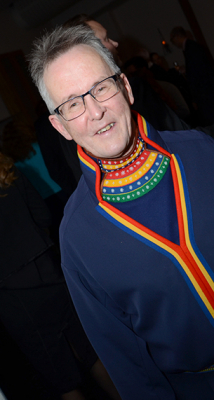
Ivan Eriksson is Sami and he has been working with projects to strengthen and further the Sami-culture for most of his life. He has always had one leg in reindeer husbandry and working to strengthen Sami rights has always been close to his heart. When he heard about the opportunity to do something during the special UN-year he knew that he had to make something extraordinary.
“I put together a project that I called “The Sami, Sweden and the future”, says Ivan Eriksson.
Photo by Kent Norberg
Back in time, the indigenous Sami people lived a nomadic life, working with their reindeer herds and moving along them during the seasons. To protect themselves from the nature and wildlife they used lávvus consisting of straight wooden poles leaned against each other, a fire in the centre and a sheet of animal hides wrapped around the bars.
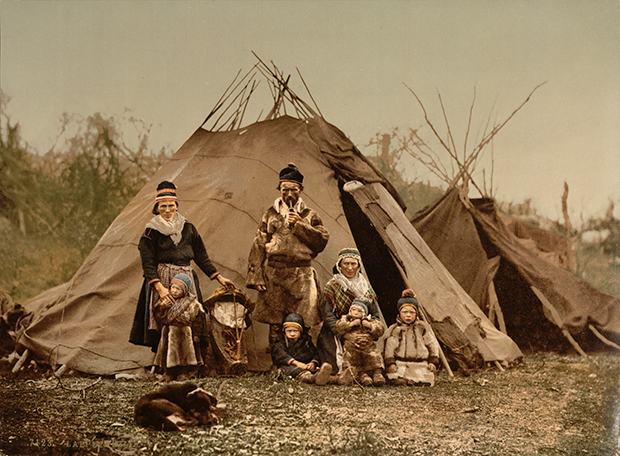
Ivan’s vision was to create a huge booth at an annual trade show in Umeå in northern Sweden, like a Sami settlement, where Sami people could show different parts of their culture, life and craftsmanship and sell handmade products.
It was at this stage that Tentipi came into the picture. The company, at that time known by its former name Moskoselkåtan had started to make a name for themselves in northern Sweden. CEO and founder Bengt Grahns vision with the company was to create a spacious tent with plenty of room to socialize.
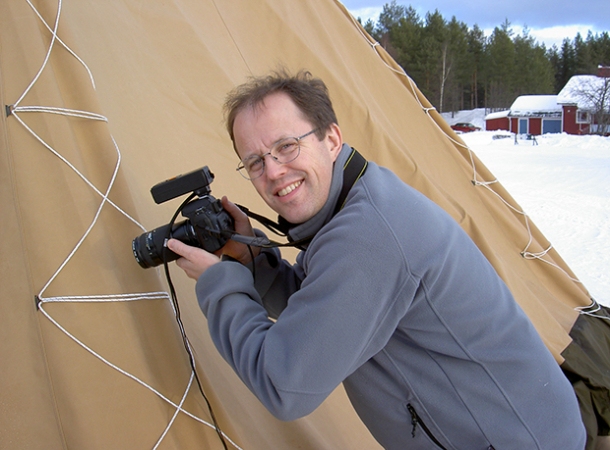
Born and raised in northern Sweden Bengt Grahn had lived close to the Sami culture and took inspiration from the design principles of the traditional Sami kåta when he created the first Nordic tipi.
An enormous tipi
Ivan Eriksson had seen the Nordic tipis from Tentipi in use in the reindeer husbandry by fellow Sami people. He thought they would be a nice addition to the booth and contacted Bengt to ask if they could do something together. Bengt Grahn had already experimented with some larger tipis but it was with this cooperation that the tipi took the form of the “giant hat” for the first time.
The booth was set to be over 1000 square metres. To fill out that enormous space a truly giant tipi was needed. To be able to display as much of the Sami craft as possible, Bengt got the idea that they needed to be able to open the sides of the tent. That way the trade shows visitors could get a better view of what was inside, and of the tent itself.
“I had previously tried to just roll up the edges of the brim, but that took away so much of the space”, says Bengt Grahn.
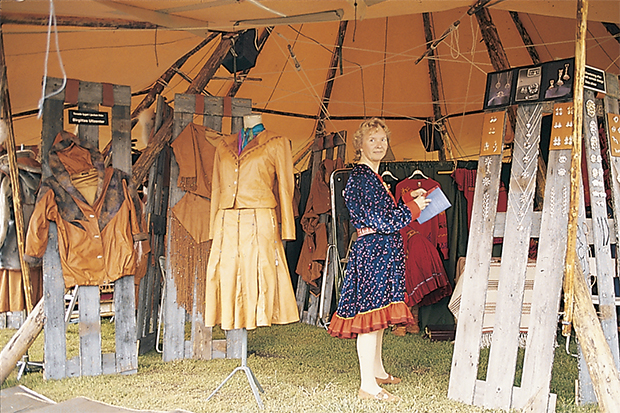
He then got the idea to install expansion wedges in the tent canvas. When the tipi was closed it looked like an ordinary Nordic tipi, but the extra flaps made it possible to open the brim of the tent, creating a much larger area for the roof. Stratus 72 was born.
”It was really something extra when you walked into it. The hat shaped tipi creates a special atmosphere and then there were all the fantastic Sami crafts to discover”, says Bengt Grahn.
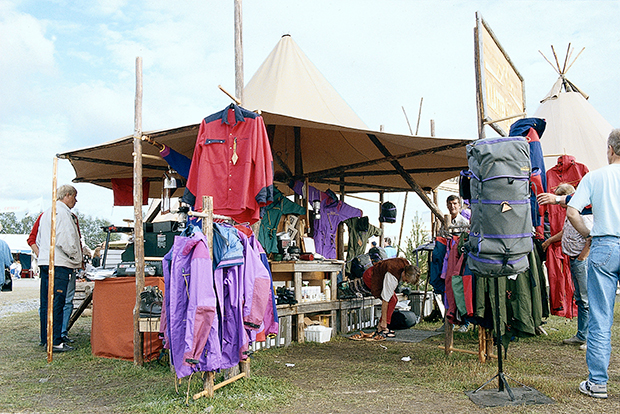
Over the coming days, thousands of visitors got to experience a piece of Sami culture inside the huge tent. They even had a pen of live reindeers and a mobile slaughterhouse.
“It was a lot of work to be able to have live reindeers on site. Usually, you are not allowed to move these animals, so we had to get a special permission from the government. We had to build a special carriage with smooth walls as to not damage their antlers”, says Ivan Eriksson.
Important event
The trade show also gave an opportunity to educate and inform the general public about Sami culture, the oppression and the hardship that they have suffered from throughout history, and their hopes for the future. Per Unckel, minister of Education and Sami-related issues was there, they had debates, and a special TV-broadcast was produced on site.
“I believe that this project was important for us Sami-people who were there. It was the first year since the founding of the Sami Parliament and it was a lot of things going on. We were optimistic and had high hopes for the future” says Ivan.
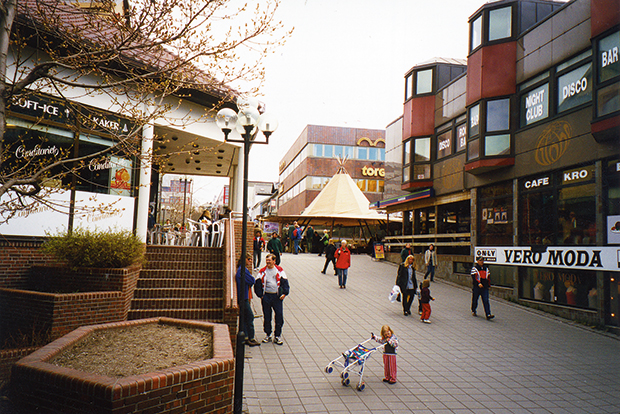
Almost 30 years has passed since that event. According to the Sami parliament there are between 20.000-40.000 Sami people in Sweden. In 1977, the Swedish Riksdag recognized the Sami as an indigenous people in Sweden. Since 2011 the Sami are recognized as a people in the Swedish constitution. Ivan Eriksson says that some things have improved for the Sami people, but it is still a long way to go. He says that new people are in charge, and the forums for where the discussions take place changes, but the issues that they are fighting for are still the same.
“The protection for our Sami rights, the Sami people and our business is not always great”, says Ivan Eriksson.
Cultural appropriation
Lately within many indigenous groups around the world there has been discussions about cultural appropriation, where people, companies or organization that are not part of an indigenous group uses elements from indigenous cultures inappropriately or without acknowledgement. Ivan Eriksson says that Sami people also been the victim of cultural appropriation when people have wrongfully claimed to have a Sami background and have used that for their gain or as to develop their business.
“It makes me upset when people claim to be Sami, but who does not have that background. It should be considered a crime against humanity to try to steal someone’s identity. But it is a whole other thing with people that are interested in our culture and want to learn about our lives. That is not a problem”, says Ivan Eriksson.
Bengt Grahn is not a Sami, but growing up in northern Sweden, he encountered a lot of Sami people and their culture at an early age.
“My family had a really good relationship with the Sami people and my dad was even part owner of a reindeer mark. That is a story of its own, but it has to do with a favor that he once did for the Sami”, says Bengt Grahn.
For Bengt Grahn and Tentipi it has always been of utmost importance to act respectfully towards the Sami.
“A lot of indigenous people has a tendency to be exploited. People romanticize and make a big deal out of them, for me it has always been important to not do any of that. To respect their culture and to not use their colors without acknowledge it correctly.”, says Bengt Grahn.
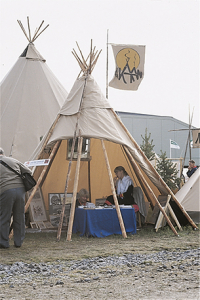
Cooperation
When Bengt developed the first Nordic Tipi, lavvús or tipis was not really being used by the reindeer herders. Bengt wanted to take what was special about the traditional tipi, which was the circular shape, being able to have a fire in the middle and the stable construction but to do it with modern materials, taking the kata to the 21st century.
“I wish that I instead could be a support. I know that a lot of reindeer herders use our tents up in the mountains. But I also hope that we can help to share their culture in the world”, says Bengt Grahn.
Ivan Eriksson agrees and believes that the way forward is to work together, if you act with respect towards each other it will benefit both parties.
“I do believe that Tentipi has contributed to making the Sami people and our culture more visible. The products originated from our culture and are used by us, both for recreational use and in the work with the reindeer", says Ivan Eriksson.
Both Bengt Grahn and Ivan Eriksson thinks back on the trade show as a success. For Ivan it meant that a lot of people got to hear about the message that they wanted to convey, and for Bengt it was the starting point for Stratus 72, which has become an especially important part of business for Tentipi.
“It turned out really well, it was a win-win situation for the both of us", says Ivan Eriksson.
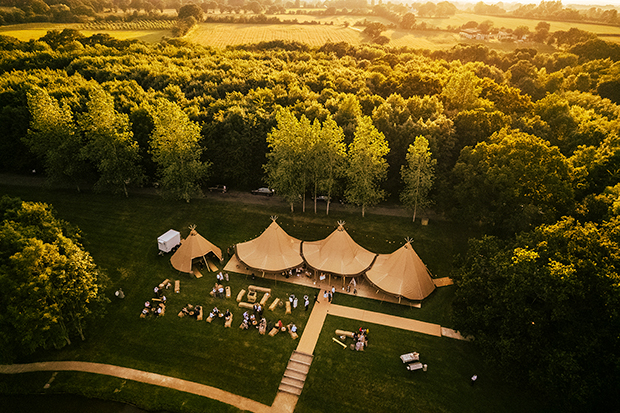 Photo by Elmbridge Farm, UK
Photo by Elmbridge Farm, UK
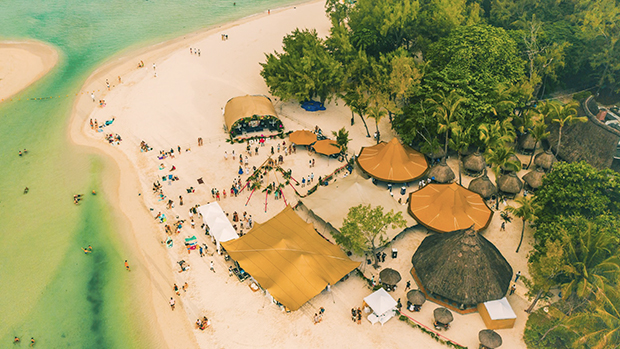 Photo by Le Tipis De Mare, Mauritius
Photo by Le Tipis De Mare, Mauritius
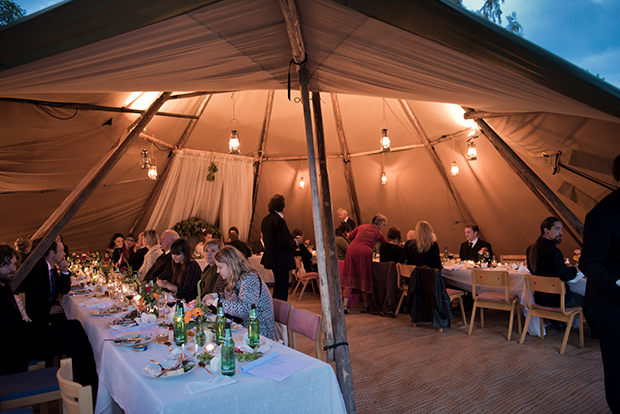 Photo by Tentipi Sweden
Photo by Tentipi Sweden
Related blog posts
Sapmi Nature Camp – Sami culture and glamping in the arctic
Torsdag 30 december 2021
Lennart Pittja is a Sámi entrepreneur with a mission: with his world-renowned eco-tourism company he wants to spread the knowledge about his people – the Sami, indigenous of northern Scandinavia and Russia. With over 20 years of experience as a wildlife guide and nature photographer in the arctic region he started Sápmi Nature Camp. Where his guests stay in Nordic tipis from Tentipi on his reindeer herding land outside of Gällivare, in northern Sweden.
At Sapmi Nature camp you can experience real winter, see the northern lights, eat traditional Sami food, and have a cultural exchange in a genuine atmosphere. The scenic location has gained attraction from around the world. In 2017 it was listed by National Geographic as one of the top 21 places in the world to visit if you care about the planet.
Luxurious glamping in arctic Sweden
Fredag 21 maj 2021
From all around the world top businessmen, Russian oil oligarchs and Hollywood celebrities travels to the tiny village of Lassbyn in Norrbotten, northern Sweden. Here our long time customer Fredrik Broman runs Aurora Safari Camp, the world’s first glampsite in an arctic winter climate. The popular destination has been long in the making and started over 20 years ago on the African savannah.
Fredrik Broman is born and raised along the Råne river valley in Norrbotten. The forest, the flowing waters and photography are passions that have been important all through his life. Fredrik is a trained teacher and as part of his teaching degree he travelled to Kenya in the late 90’s to work at the Swedish school in Nairobi and to write and take photos for a textbook. As time went by he got to spend more time with his camera and developed his great interest in photography.
Tipi Unique On Adapting and Staying Positive
Onsdag 30 september 2020
There is no denying that times are challenging for all of us who work in the events industry.
Despite the restrictions being placed on the industry we are seeing many of our customers adapt and find new ways to work.
Karen Thorp-Cleaver, owner of prize winning UK rental business Tipi Unique, tells us the story of how she and her team have adjusted to the ‘new normal’ and her belief that the events industry will recover…
Create More Event Space With Tentipi
Onsdag 20 maj 2020
As the world emerges from lockdown, the immediate challenge for the hospitality, event and sporting industries is the need for extra space.
Safe social distancing solutions are the key to getting back to business.
For 31 years Tentipi Event Tents have been supplying imaginative, practical and beautiful structures to pubs, bars, restaurants and venues around the world.
Fully engineered and meeting international fire safety standards, Tentipi Event Tents are easy to build and fast to install.
Tentipi ANTA Photo Competition
Måndag 4 maj 2020
Tag us in your photos and be in with a chance to win a Zirkon 7 Tentipi Adventure Tent.
We are also giving away a Tentipi Hammock every week for 12 weeks.
The closing date for the Zirkon tent prize is 31st July 2020.
The overall winner will receive a Zirkon 7 Tentipi Adventure Tent (worth £1350).
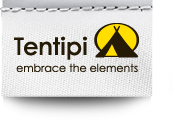
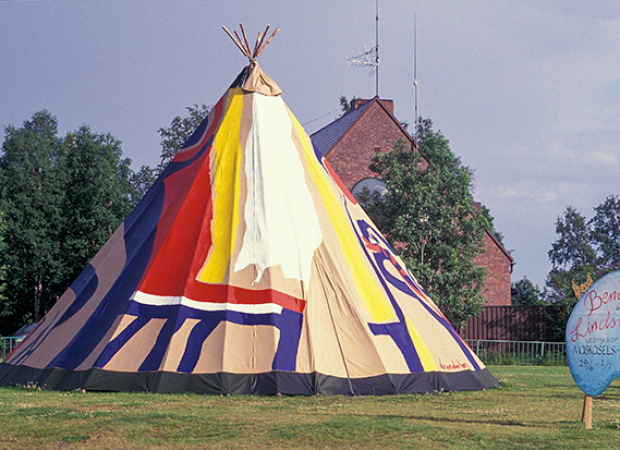





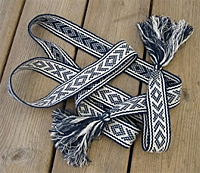


Please click the 'Add comment' button below if you wish to comment.